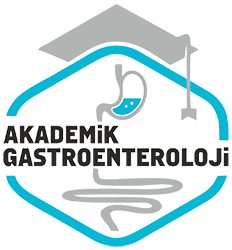Aralik 2011
Peptik ülser ve kanser teshisinde özofagogastroduodenoskopi
Esophagogastroduodenoscopy for peptic ulcer and cancer
- Ana Sayfa
- Sayılar
- Aralik 2011
- Peptik ülser ve kanser teshisinde özofagogastroduodenoskopi...
Vakif Gureba Egitim Hastanesi, 2Gastroenteroloji Klinigi, Istanbul
Özet
Giriş ve Amaç: Bu çalışmada klinigimizde yapilmis olan özofagogastroduodenoskopi sonuçlarını değerlendirerek, peptik ülser ve kanser sikligini tesbit etmek amaçlanmıştır. Gereç ve Yöntem: Nisan 1998, Temmuz 2004 tarihleri arasında Vakif Gureba Egitim Hastanesi Iç hastalıklari Endoskopi Ünitesinde yapilmis olan 5306 gastroskopik inceleme retrospektif olarak incelendi. Hastalar isleme 10 saatlik kati ve 5 saatlik sivi kisitlamasini takiben alinmislardir. Premedikasyonda xylocain sprey, islemde videoendoskoplar kullanilmıştır. Islemler deneyimli gastroenterologlar tarafindan ve sedasyonsuz gerçekleştirilmiştir. Bulgular: Hastaların 2538?i (547.8) erkek, 2774?ü (%52.2) kadın; yaş ortalaması 48.28; yaş dagilimi 13-94 idi. En sık görülen bulgu midede normal/antral gastrit (%59.6), duodenumda ülser (%14.8), özofagusta özofajit (%7.4)?tir. Özofagusta 18 (%0.33), midede 93 (%1.75), duodenumda 5 (%0.09) tümör saptanmıştır. Hastalar islemi sedasyonsuz rahat tolere etmislerdir ve islemler esnasinda komplikasyon olmamıştır. Sonuç: Özofagogastroduodenoskopi sedasyonsuz rahat tolere edilen, komplikasyonlarin sifira yakin olduğu, bir tanısal modalitedir. Bu yöntemle peptik ülser yakalama olasiligi yüzde 16.5; tümör yakalama olasiligi özofagus için yaklasik binde 3.3, midede binde 17.5, duodenum için binde 0.9?dur.
Abstract
Background/aims: The purpose of this trial was to evaluate outcomes of endoscopic findings in our patients with peptic ulcer and cancer incidence. Material and Methods: The records of 5306 esophagogastroduodenoscopy procedures performed between April 1998 and July 2004 in the Internal Medicine Clinic, Endoscopy Unit, of Vakif Gureba Training Hospital were evaluated retrospectively. Results: 2538 (47.8%) of the patients were male and 2774 (52.2%) female; the mean age was 48.28 (range: 13-94 years). The most common findings were normal/antral gastritis in 3166 patients (59.6%), duodenal ulcer in 790 (14.8%) and esophagitis in 395 (7.4%). Patients tolerated the procedure without sedation or complication. Conclusions: Esophagogastroduodenoscopy was a well-tolerated procedure without sedation or complication. We evaluated the incidences of malignancy as 0.33% for the esophagus, 1.75% for the stomach and 0.09% for the duodenum.



